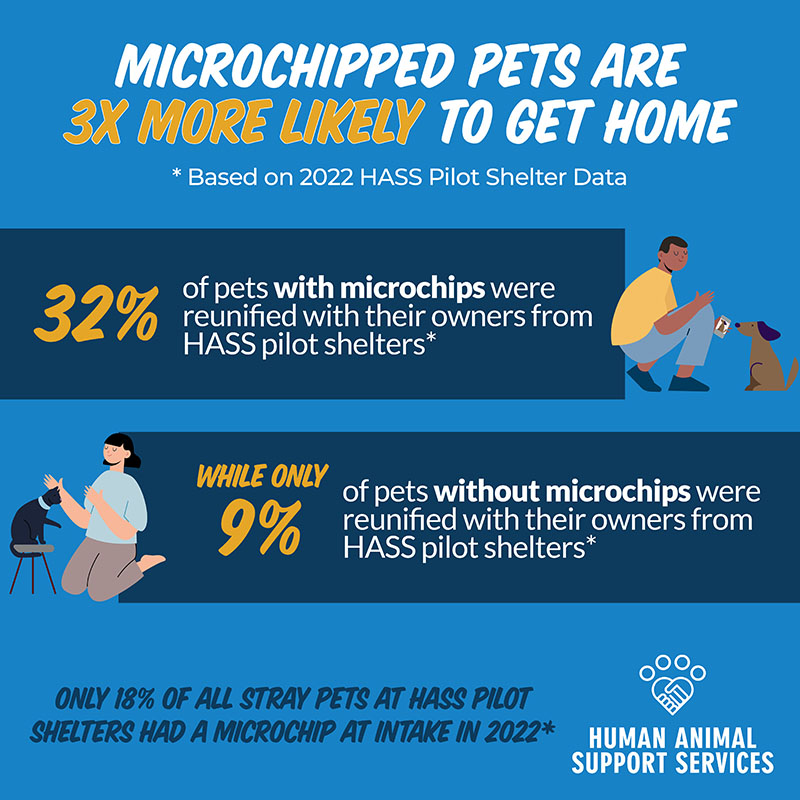It’s long been known that lost pets with microchips have a higher chance of returning to their homes than those without. New analysis from the HASS data team shows that pets with microchips are in fact three times more likely to be reunited with their families as those without—but that the use of microchips could be so much more effective.
Read on for tips on what shelters can do to have those chips more effectively work to reunite pets with their families.
HASS Data Is Clear—Microchips Work, and They Could Work Even Better
As the data team works on one of the main pathways of the HASS service model, Lost Pet Reunification, we took a look at what is happening with microchips among the lost pets that come into the HASS pilot shelters—for this analysis, we examined data from 17 government-funded shelters that collect information about chips on intake, and whose annual intake numbers range from 3,300 to over 45,000.
What we found confirms again that microchips—along with other forms of pet identification—are effective: On average, pets with a microchip were over three times more likely to be reunified with their families than those without.
Three times more may seem like a lot of animals are going back to their homes, but HASS pilot shelters also record that only 18% of stray pets—roughly 1 in 6—have a microchip at the point of intake. This means that only a minority of the pets even have the tripled advantage bestowed by a microchip.
Additionally, even pets who do have a microchip are often not getting their full benefit. From 2019 to 2021 in HASS pilot shelters, for example, on average, 57% of chipped dogs go home, and 22% of chipped cats.
While the species gap would surprise no one familiar with national shelter data, these figures mean that 43% of chipped dogs and 78% of chipped cats are still not being returned to their homes once they enter a shelter. These numbers should make us ask questions about what can be done to close this gap.

Since the majority of pets that enter shelters are classified as strays (most presumed to be lost pets), efforts to get more pets back to their owners offer lots of opportunity for decreasing the burden of shelter populations.
Pets who enter shelters with a microchip are known to have had a caregiver. They are the low hanging fruit for pet reunification and a good place to start for any shelter wanting to avoid or mitigate a space crisis.
But how to improve? The HASS data team has been working on some longer-term, proactive ways to increase the benefits of microchipping among our pilot shelters. Read about these in an upcoming blog.
What Shelters Can Do Today to Get More Pets Home
With July 4th fast approaching, the holiday that typically results in more lost pets, we wanted to put out the message about a relatively simple and quick way to improve on returning pets to their families.
A microchip is only as good as the information it links to. Consider taking steps now to ensure that microchips are properly registered with accurate and up-to-date information:
- Ensure all adopters register their microchips at the point of adoption
- Reach out to past adopters to remind them to update the contact information registered with pets’ microchips (and tell them how to do this)
- Use your external communications, your website, newsletters, social media, and the media, to remind the wider pet owning population in your community that a microchip is of little use without up-to-date contact information—with information about how to update microchip info for pets
While the HASS data team has not (yet) compared the advantages of microchips to other forms of pet identification like old-school collars with tags, or newer tags with QR codes, any form of identification is better than none.
The major point is that it benefits shelters to ensure the community’s pets can be reconnected with their families easily, and are well-advised to consider finding ways to make this happen.
As animals flow into shelters at a greater rate than they are leaving, a crisis is developing—and has developed—nationwide. Many factors are driving this problem and no single solution will solve it.
It makes sense to closely identify what factors are driving overcrowding in each community’s shelter—and also where there is easy opportunity—so that precious time and resources can be used most effectively.
Data helps point the way—and here, it points the way toward making sure microchips are being used most effectively.
Tom Kremer is a Data Analyst for the Human Animal Support Services project. Before joining HASS, Tom completed and published a research project analyzing shelter and census data geographically with Dallas Animal Services and built interactive dashboards for multiple US-based shelters. He holds a BSc in Data Science and BA in Philosophy from Minerva University.






